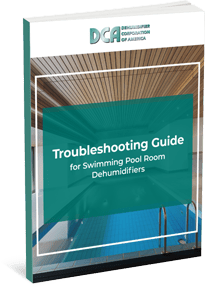Engineers and operators for fresh water and wastewater treatment facilities know the hazards and frustrations that come along with maintenance and housekeeping for the facility. These operations inevitably raise the moisture content of the air, which leads to rust and corrosion of the equipment, and eventually to the presence of mold and mildew within the facility.
Rust and corrosion can lead to the early degradation of a wide range of plant equipment. Mold and mildew pose a health hazard for workers within a treatment facility and may also contaminate fluids the facility is meant to purify. Depending on the type, size, and location of the facility, other moisture-related hazards could be present, and what works in one place may not be effective in another.
Fresh Water Facilities
Harmful moisture often originates from the cold water running through the fluid system. Water sourced from the ground or a lake can be as cold as 33° F during cold seasons. When water of a certain temperature is introduced to the surface in a facility with a higher ambient temperature (such as a metal pipe), the cooler temperature of the water in the pipe causes the moisture in the warmer air to condense and gather on the equipment.
This means that the ambient air has reached its dew point. This can become especially problematic in the warmer months. Above-ground fresh water facilities typically bring in outdoor air, bringing in additional moisture to the facility. Even though such equipment is coated with a protective finish, the occurrence of moisture resulting from normal operations will eventually degrade pipe galleries, water holding tanks, pumps, and metal fittings.
Wastewater Facilities
Wastewater facilities face many of the same housekeeping challenges as those associated with fresh water facilities, but with an added hazard. Wastewater facilities must also mitigate the possibility of contaminating the air with methane or other combustible gases generated by wastewater treatment.
Fighting Corrosion, Rust, and Mold/Mildew via Dehumidification
In the cases of both fresh water and wastewater treatment facilities, the challenge of moisture control can be met by employing a dehumidification system tailored to the specific needs of the facility. Dehumidifier Corporation of America’s (DCA) industrial dehumidifiers are sized to control humidity relative to a dew point of five degrees below the coldest surface temperature present.
In wastewater facilities where combustible gases may be present, the dehumidification system must also be constructed to Class 1 – Division 2 of the NEC code standards for explosive environments.
Industrial Dehumidification Solutions from DCA
DCA’s ability to tailor a dehumidifier to a plant’s specific needs prevents condensation in an efficient manner, adding years of life to plant equipment and helping to provide a hazard-free work environment within the facility.
To see how we can help address your moisture control issues, please consider this case study, where DCA applied the principles of efficient dehumidification to a fresh water treatment facility in Foxboro, Massachusetts.
We can help you identify and control moisture problems in your fresh or wastewater plant by suggesting a dehumidification solution tailored to your exact needs. For questions, quotes, or more information about our extensive product line of industrial dehumidifiers, please don’t hesitate to contact us.





